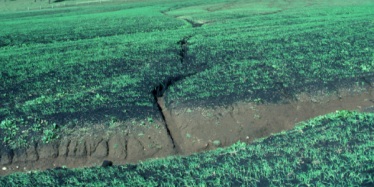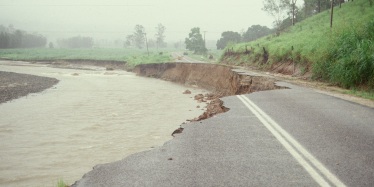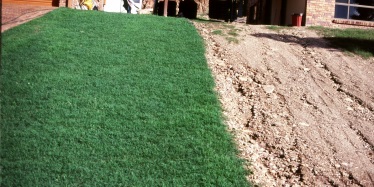Impacts of erosion
All soils can suffer erosion but some are more vulnerable than others. Soils with dispersible subsoils, for example, are subject to serious erosion by tunnelling and gully formation.
Understanding the type of soil and how prone it is to erosion can help avoid problems in agriculture and on waterways and infrastructure.
Agriculture
Soil erosion removes valuable top soil which is the most productive part of the soil profile for agricultural purposes. The loss of this top soil results in lower yields and higher production costs.
When top soil is gone, erosion can cause rills and gullies that make the cultivation of paddocks impossible.
The impacts of erosion on cropping lands include:
- reduced ability of the soil to store water and nutrients
- exposure of subsoil, which often has poor physical and chemical properties
- higher rates of runoff, shedding water and nutrients otherwise used for crop growth
- loss of newly planted crops
- deposits of silt in low-lying areas.

In Queensland
Queensland farmers have been cultivating the land since the 1850s. However, early farmers were not aware that some of their farming practices were causing erosion.
By the 1950s, soil erosion was seriously threatening the productivity of fertile cropping areas such as the Darling Downs and the Inland Burnett.
Around 3 million hectares or 2% of Queensland is now used for growing crops.
Our principal cropping areas are the Western Downs, Darling Downs, Inland Burnett, Dawson–Callide, Central Highlands, Atherton Tablelands and the horticulture and sugarcane areas along the east coast.
Around 80% of the state’s cultivated area is vulnerable to soil erosion. If nothing is done to protect the soil, losses can be very high. Soil erosion has been so severe that some areas of Queensland are now unsuitable for cropping.
Soil losses from unprotected cultivation in upland cropping areas of the Darling Downs can average between 20 and 60 tonnes per hectare per year. Steep, unprotected cropping lands in tropical areas can lose up to 400 tonnes of soil per hectare per year.
Waterways
Downstream effects of soil erosion include:
- siltation of watercourses and water storages
- reduction in water quality of creeks, rivers and coastal areas.
Eroded soil, which can contain nutrients, fertilisers and herbicides or pesticides, can be deposited where there is a reduction in the slope of the land. This can be in sediment traps, along contour banks, or in grassed waterways, dams or wetlands.
Heavier soil particles are the first to be deposited, while finer colloidal clay particles may remain in suspension. Soil removed by gully erosion (especially finer colloidal clay) may be transported directly to creeks or rivers.
Reef water quality
The Great Barrier Reef is the largest coral reef in the world.
The quality of water flowing from the land into the reef lagoon has deteriorated over the past 150 years.
Major floods deliver large levels of pollutants (including eroded soil) from river catchments onto the reef.
Read more about reef water quality.

Infrastructure
Almost 45% of Queensland has soils with some sodic properties. These soils are especially vulnerable to most forms of soil erosion and can affect infrastructure projects such as:

- dams and embankments—if dispersible soils are not compacted properly during construction, air voids occur. Water can easily get into these void spaces and cause dispersion of the surrounding soil. Small ‘pipes’ can form which quickly develop into tunnels. This has been known to cause piping and bank failure within a few hours when a new dam is filled for the first time.
- road and tracks—bitumen and concrete readily produce runoff. To build roads, the land has to be disturbed, so erosion and siltation can occur if special stabilising techniques are not used.
- urban developments—can cause severe soil erosion if the land is unsuitable to be built on and developments run through existing drainage lines.
- mining and exploration activities—interfere with the natural drainage of the landscape which can cause erosion and siltation of waterways. Mining exploration requires the development of hundreds of kilometres of tracks and roads from which vegetation is cleared, leaving the soil more vulnerable to erosion.


